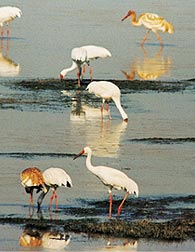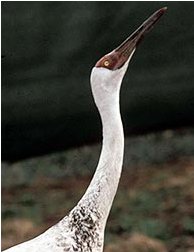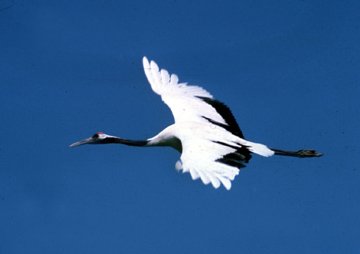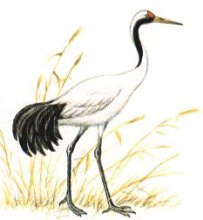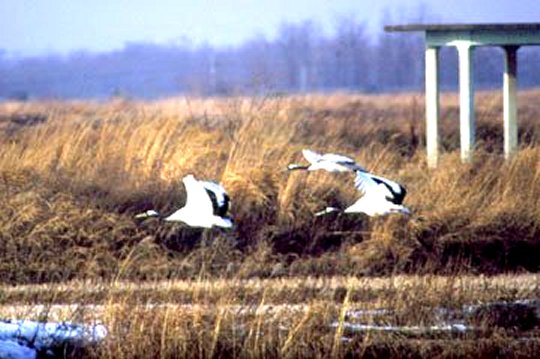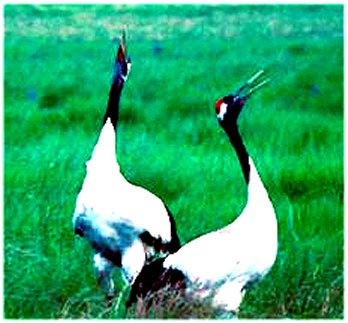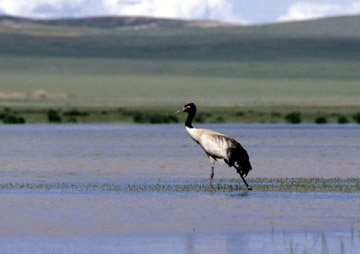Siberian
Crane, Grus leucogeranus 
Siberian
White Crane, Snow Crane
|
Red
List Category & Criteria: CR A3cde ver 3.1 (2001)
Year Assessed:
2007 Assessor/s: BirdLife International
Evaluator/s: Bird, J., Butchart, S. & Crosby, M. (BirdLife
International Red List Authority)
Justification: This long-lived crane qualifies as Critically
Endangered owing to fears that its global population will
decline extremely rapidly over the next three generations
following the development of the Three Gorges Dam in China
which threatens the wintering grounds used by the vast majority
of individuals. If the impacts of this development prove to
be less damaging than is feared, the species may warrant downlisting.
History: 1988 - Threatened (Collar and Andrew 1988)
1994 - Endangered (Collar, Crosby and Stattersfield 1994)
2000 - Critically Endangered (BirdLife International 2000)
2004 - Critically Endangered (BirdLife International 2004)
2006 - Critically Endangered (BirdLife International 2006)
©IUCN 2008. 2008 IUCN
Red List of Threatened Species. <www.iucnredlist.org>.
Downloaded on 11th April 2008.
|
The Siberian Crane, Grus leucogeranus, also known as
the Siberian White Crane or the Snow Crane, is a bird of the
family Gruidae, the cranes.
|
picture
hopefully to come
2006: only two Siberian Cranes (both males) return to
the wintering site
in northern Iran in October, one disappears later.
|
This species breeds
in arctic Russia in Yakutia and western Siberia. It is a long
distance migrant. The eastern population winters
on the Yangtze River and Lake Poyang in China, the central
population at Keoladeo
National Park, India and the western
population in Fereidoonkenar and Esfahan in Iran. It breeds
and winters in wetlands, where it feeds on the shoots, roots
and
tubers of aquatic plants.
This is a large
white crane.
Large males can exceed 140 cm (55 inches) in length and weigh
over 10 kg. Adults are all white, except for a dark red mask
extending from the bill to behind the eye. It has a yellow
iris and reddish legs. The male is slightly larger than the
female.
Juveniles have a feathered mask and buff or cinnamon plumage.
The voice is flute-like and musical.
 Siberian
cranes in flight, landing and taking off
Video: BBC Natural
History Unit
Siberian
cranes in flight, landing and taking off
Video: BBC Natural
History Unit
Audio: Natural FX and The British Library Sound Archive
|
The status of
this crane is critical, as it is expected to undergo a rapid
population decline in the near future. The wintering site
in
China holding 95% of the population is threatened by hydrological
changes caused by the Three Gorges Dam. The population is
estimated to be around 2000 in China.
Historic records
from India suggest that a number of them wintered there in
the past. In fact, Ustad Mansur, a 17th century
court artist of Jehangir, was the first man to accurately
paint the Siberian Crane. However, the number of birds wintering
in
India has steadily declined and the birds are no longer found
there.
|

At almost 4,000 miles, the Yangtze is the fourth longest river
in the world, discharging into the sea about twice the water
of the Mississippi. For as long as people have kept records,
the Yangtze has been in the habit of periodically overflowing
its banks and flooding vast areas. Controlling that ancient
threat, along with producing electricity, are the main goals
of the Three Gorges Dam

NASA/Goddard
Space Flight Center Scientific Visualization Studio
http://projectpowerplant.com
At left is a 1987 bird’s eye view of the Three Gorges
Dam region as seen with Landsat-5 satellite.
At right is a 2006 bird’s eye view of the Three Gorges
Dam region as progress on the dam is well underway.
|
Red-crowned
Crane - Grus japonensis
|
The Red-crowned Crane, Grus japonensis
(japonicus), also called the Japanese
Crane or Manchurian Crane (Chinese: Hanyu Pinyin: Danding
Hè; Japanese: tancho,
is a large east Asian crane and among the rarest cranes
in the world. In some
parts of its range, it is known as a symbol of luck,
longevity and fidelity.
Adult Red-crowned Cranes are snow white with black
to the wings (appears
almost like a black tail when standing, but the real
tail feathers are white),
blackish to the head and neck, and a patch of red skin
on the crown.
This patch of skin becomes brighter red when the crane
becomes angry or excited.
This species is among the largest cranes, typically
measuring about 158 cm tall,
136 cm in length (from bill to tail tip) and spanning
242.5 cm across the wings.
Typical body weight can range from 7 to 10 kg , with
males being slightly larger
than females and weight ranging higher just prior to
migration.
|
|
|

Japanese
crane, Grus japonensis - Overview
BBC Natural History
Unit
http://www.arkive.org
|
 Japanese
crane, Grus japonensis, displaying
BBC Natural History
Unit
Japanese
crane, Grus japonensis, displaying
BBC Natural History
Unit
http://www.arkive.org |
In the spring and summer, the migratory populations of the Red-crowned
Crane breed in Siberia (eastern Russia),
northeastern China and occasionally in northeastern Mongolia
(i.e., Mongol Daguur Strictly Protected Area). Normally the
crane lays 2 eggs, with only one surviving. Later, in the fall,
they migrate
in flocks to Korea and east-central China to spend
the winter. Vagrants have also been recorded in Taiwan. In addition
to the migratory
populations, a resident population is
found in eastern Hokkaido in Japan. The habitats used are marshes,
riverbanks, rice fields, and other wet areas.
The estimated total population of the species is only 2,750
in the wild, including about 1,000 birds in the resident Japanese
population. Of the migratory populations, about 1,000 winter
in China (mainly at the Yellow River delta and Yancheng
Coastal Wetlands, and the remaining winter in Korea. Several
hundred Red-crowned Cranes are kept in zoos around
the world.
The Siberian Crane nests in bogs, marshes, and other wetland
types of the lowland tundra, taiga/tundra transition zone,
and taiga, preferring wide expanses of shallow fresh water with
good visibility. Females usually lay two eggs and incubation
(by both sexes) lasts ~29 days. The male takes the primary role
in defending the nest against possible danger.
Chicks fledge (first flight) at approximately 70-75 days.
All cranes are omnivorous. Siberian Cranes eat a wide variety
of food items. On the breeding grounds in spring, they eat
cranberries, rodents, fish and insects. They have a propensity
for digging in wet soils. On migration
and on the wintering
grounds, they excavate nutrient rich roots and tubers from wetlands.
They are predominantly vegetarian outside their
breeding season.
Source: Wikipedia and ICF
Black-necked
Crane, Grus nigricollis

|
The Black-necked Crane, Grus nigricollis,
is a medium-sized crane that is found on the Tibetan Plateau
of Asia.
It is 139 cm long with a 235 cm wingspan, and it weighs 5.5
kg. It is whitish-gray, with a black head, red crown patch,
black upper neck and legs, and white patch to the rear of
the eye. It has black primaries and secondaries. Both sexes
are
similar. Some populations are known to make seasonal movements.
It is revered in Buddhist traditions and culturally
protected across much of its range.The Indian state of Jammu
and Kashmir considers it as the state bird.
This medium-sized crane is mostly grey with a black head and
neck. The lores and crown are naked and dull red. A small
patch of white feathers are present below and behind the eye.
The tail is black and makes it easy to distinguish at a distance
from the similar looking Common Crane which has grey tail.
The breeding areas are alpine meadows, lakeside and riverine
marshes and river valleys. They also make use of barley and
wheat fields in these areas. Wintering areas tend to be in
sheltered valleys or lower altitudes. The largest populations
are in
China and Tibet with smaller numbers extending into Vietnam,
Bhutan and India. Small populations have been noted in
northern Sikkim. A small group of 20 to 40 was once known
to regularly visit the Subansiri area in the Apa Tani valley
until 1975 and vagrants have been recorded in Nepal.
Currently, the Black-necked Crane winters in small numbers
in two valleys of western Arunachal Pradesh, India.
These are Sangti and Zemithang.
Total number as per 2001 is estimated about 6.000.
 Black-necked
Crane, Bronx Zoo, New York
Black-necked
Crane, Bronx Zoo, New York
Photo: Eric Savage
http://en.wikipedia.org/wiki/File:Grus_nigricollis_-Bronx_Zoo-8-3c.jpg
|
Black-necked Cranes forage on the ground in small groups,
often with one bird acting as a sentinel. In winter, the groups
arrive and leave the feeding grounds together, but may split
into family groups, each group keeping their own small feeding
territories in a big marshes or fields.[6] They spend nearly
75% of the day foraging with peak feeding in the early morning
and late afternoon. While foraging, they keep walking and
they also walk long distances between the feeding spots.
In this manner, they cover several kilometers a day while
foraging. They feed on the tubers of sedges, plant roots,
earthworms, insects and other invertebrates, frogs and other
small vertebrates. They may also feed on fallen grains of
barley,
oats and buckwheat and will sometimes dig up and feed on potatoes,
carrots and turnips.
These birds are very wary, but in some areas they are accustomed
to the local people who do not disturb them.
These cranes appear to be able to distinguish people in traditional
dress and are especially wary of others.
 A
1938 photograph of a flock in the Brahmaputra valley
http://en.wikipedia.org/wiki/File:Bundesarchiv_Bild_135-S-15-18-08,_Tibetexpedition,_Schwarzhalskraniche_cropped.jpg
A
1938 photograph of a flock in the Brahmaputra valley
http://en.wikipedia.org/wiki/File:Bundesarchiv_Bild_135-S-15-18-08,_Tibetexpedition,_Schwarzhalskraniche_cropped.jpg
|
Threat.
The estimated population of the Black-necked Crane is
between 8800 and 11000 individuals. These birds are
legally
protected in China, India and Bhutan. However habitat
modification, drying of lakes and agriculture are threats
to the
populations. In many areas, dogs belonging to herders
are a major threat to young birds. Collisions with power
lines
has been another cause of mortality in some areas. Eggs
may also be preyed on by ravens that may use the opportunity
provided when humans disturb the parents. The drying
of wetlands can cause increased accessibility of the
nests leading
to predation while a rise in the water level can submerge
nests.Loss and degradation of habitat are the main threats
facing the Black-necked Cranes. The problems are most
serious in the wintering areas, where wetlands are extensively
affected by human activity including irrigation, dam
construction, draining, and grazing
pressure. In Tibet, widespread
changes in traditional agricultural practices have reduced
the availability of waste barley and spring wheat.
|
 Black-necked
crane defending nest site
Video: BBC Natural
History Unit
Black-necked
crane defending nest site
Video: BBC Natural
History Unit
Audio: Natural FX and The British Library Sound Archive
|
|
|
When nothing else stated, all pictures courtesy
of
International Crane Foundation, Baraboo, Wisconsin. www.savingcranes.org
|
|





